Osteopathy
> Stefanosala2
La lattoferrina: una potente difesa antivirale - RobertoGava.it. Manipulation of the Fascial System Applied During Acute Inflammation of the Connective Tissue of the Thoracolumbar Region Affects Transforming Growth Factor-β1 and Interleukin-4 Levels: Experimental Study in Mice. Introduction Fascia is a connective tissue composed of collagen fibers (Willard et al., 2012) that enables sliding between surfaces (Langevin et al., 2011); it is known that it has an important role in locomotion withal, as it acts as a transmission force mechanism between adjacent synergist and antagonistic muscles (Garfin et al., 1981).
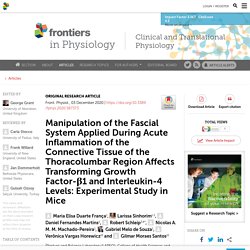
It has been suggested that this transmission force mechanism occurs via collagen fibers of the connective tissue (Huijing and Baan, 2008), which shares the mechanical stress during muscle contraction (Findley et al., 2015). Moreover, the fascia resistance to pressure and traction depends on its extracellular matrix (ECM) content (Bhattacharya et al., 2010), which can be affected by inflammatory processes (Langevin et al., 2011).
Il ruolo dell'osteopatia nella diagnosi e nel trattamento degli acufeni: risultati preliminari su quattro casi - Soma Istituto Osteopatia Milano. Il ruolo dell'osteopatia nel trattamento degli acufeni miofasciali: uno studio sperimentale. The neural home where stress lives. Summary: Researchers have identified a hippocampal neural network that activates during stress.
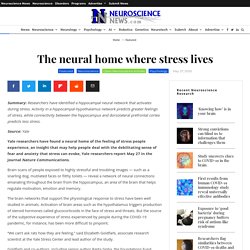
Activity in a hippocampal-hypothalamus network predicts greater feelings of stress, while connectivity between the hippocampus and dorsolateral prefrontal cortex predicts less stress. Source: Yale Yale researchers have found a neural home of the feeling of stress people experience, an insight that may help people deal with the debilitating sense of fear and anxiety that stress can evoke, Yale researchers report May 27 in the journal Nature Communications. Brain scans of people exposed to highly stressful and troubling images — such as a snarling dog, mutilated faces or filthy toilets — reveal a network of neural connections emanating throughout the brain from the hippocampus, an area of the brain that helps regulate motivation, emotion and memory.
The brain networks that support the physiological response to stress have been well studied in animals. About this neuroscience research article. Le compliance delle pagine social network alla normativa sulla protezione dei dati personali: le implicazioni per gli Enti delle professioni sanitarie. - GiornaleSanità.it. Le Algie Cervico Brachiali - Formative Zone. Physiology, Baroreceptors - StatPearls - NCBI Bookshelf. The Central tendon or Central Chain. Vagus nerve: Function, stimulation, and further research. Cerebral Perfusion Changes After Osteopathic Manipulative Treatment: A Randomized Manual Placebo-Controlled Trial. Introduction Osteopathic Manipulative Treatment (OMT) is a therapeutic approach aimed at enhancing body’s self-regulation aligned with the principles of practice and application of five models of the structure-function relationship (Thomson et al., 2011; Lunghi et al., 2016; Hruby et al., 2017).

These models (biomechanical, respiratory/circulatory, neurological, biopsychosocial, and bioenergetic) are typically used in combination to provide a framework for interpreting the significance of a somatic dysfunction (ICD-10 Clinical Modification, 2010) guiding the osteopath through diagnosis and treatment. The OMT techniques are mainly focused on correcting the somatic dysfunctions using articular and myofascial techniques, balanced ligamentous tension and osteopathy in the cranial field. Despite the evidence of OMT effectiveness, the neurophysiological mechanisms underlying clinical improvements are poorly understood.
The Other Side of the Fascia: Visceral Fascia, Part 2. I Now Suspect the Vagus Nerve Is the Key to Well-being. Have you ever read something a million times only to one day, for no apparent reason, think “Wait, what is that?” This happened to me the other day for “the vagus nerve.” I kept coming across it in relation to deep breathing and mental calmness: “Breathing deeply,” Katie Brindle writes in her new book Yang Sheng: The Art of Chinese Self-Healing, “immediately relaxes the body because it stimulates the vagus nerve, which runs from the neck to the abdomen and is in charge of turning off the ‘fight or flight’ reflex.” Also: “Stimulating the vagus nerve,” per a recent Harvard Health blog post, “activates your relaxation response, reducing your heart rate and blood pressure.” And: Deep breathing “turns on the vagus nerve enough that it acts as a brake on the stress response,” as an integrative medicine researcher told the Cut last year.
The Other Side of the Fascia: The Smooth Muscle Part 1. Cerebral Perfusion Changes After Osteopathic Manipulative Treatment: A Randomized Manual Placebo-Controlled Trial. Introduction Osteopathic Manipulative Treatment (OMT) is a therapeutic approach aimed at enhancing body’s self-regulation aligned with the principles of practice and application of five models of the structure-function relationship (Thomson et al., 2011; Lunghi et al., 2016; Hruby et al., 2017).
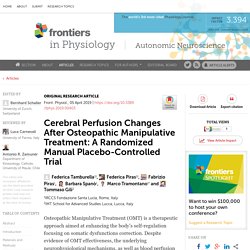
These models (biomechanical, respiratory/circulatory, neurological, biopsychosocial, and bioenergetic) are typically used in combination to provide a framework for interpreting the significance of a somatic dysfunction (ICD-10 Clinical Modification, 2010) guiding the osteopath through diagnosis and treatment. The OMT techniques are mainly focused on correcting the somatic dysfunctions using articular and myofascial techniques, balanced ligamentous tension and osteopathy in the cranial field.
Despite the evidence of OMT effectiveness, the neurophysiological mechanisms underlying clinical improvements are poorly understood.
Adrenal Fatigue: 'Just a Myth'?
Get unlimited access on Medscape.

Not a Medscape Member? Get free unlimited access to Breaking News Business of Medicine Expert Perspective Breaking News Stay informed on the latest advances in medical literature, by regulatory agencies like the FDA, and from 200+ medical conferences worldwide.
1000 Years of Osteopathy. Why Self-Regulation Is the Most Important Thing in the World. As a therapist who specializes in treating complex posttraumatic stress, I am often asked whether my practice is “depressing,” or whether it brings me down.
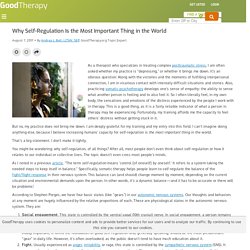
It’s an obvious question: Along with the victories and the moments of fulfilling interpersonal connection, I am in vicarious contact with intensely difficult situations and stories. Also, practicing somatic psychotherapy develops one’s sense of empathy: the ability to sense what another person is feeling and to also feel it. So I often literally feel, in my own body, the sensations and emotions of the distress experienced by the people I work with in therapy.
This is a good thing, as it is a fairly reliable indicator of what a person in therapy may be experiencing. Fortunately, my training affords me the capacity to feel others’ distress without getting stuck in it. But no, my practice does not bring me down. That’s a big statement.
Manipulation techniques for infant torticollis. Torticollis is the collective term for asymmetries of the head and neck region.
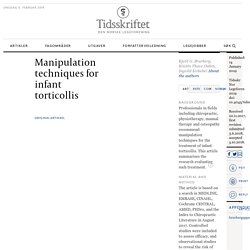
The prevalence of congenital muscular torticollis, which is often accompanied by asymmetric head shape, is estimated at about 1 % (1). A greater number of infants, around 10 % of all those under six months, have an asymmetric head shape that may be related to restricted range of motion of the neck and to a positional preference when supine (2). Figures from Statistics Norway and the Norwegian Health Economics Administration show that approximately 8 % of all Norwegian infants are taken to manual therapists in their first year, often due to head and neck-related asymmetries (3).
Vagal nerve stimulation releases vasoactive intestinal peptide which significantly increases coronary artery blood flow.
Skip to Main Content Sign In Register Close.
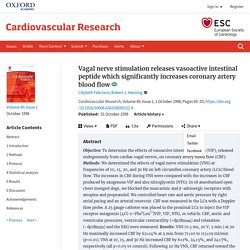
Anatomy, Abdomen and Pelvis, Quadratus Lumborum - StatPearls - NCBI Bookshelf. What Is the Molecular Signature of Mind–Body Interventions? A Systematic Review of Gene Expression Changes Induced by Meditation and Related Practices. Introduction In the past two decades, mind–body interventions (MBIs; refer to Table A1 for a list of abbreviations frequently used throughout this paper) have been gaining empirical support and recognition by mental health professionals.
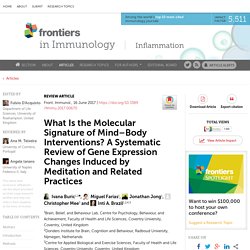
While some MBIs, such as yoga, Tai Chi, and Qigong, have a strong physical component, others like meditation and mindfulness, breath regulation techniques, and the relaxation response (RR) are mainly sedentary.
Le parasympathique sacré : naissance de l’anatomie d’un mythe. – Gestion de la douleur en Thérapie Manuelle. Considerazioni osteopatiche sulle disfunzioni della deglutizione. - Paolo Desirò. Indagini sperimentali sul ruolo del SNA nella vulnerabilità/resilienza allo stress - Osteopatianews. Prof Andrea Sgoifo, PhD, Università degli studi di Parma “Lo stress è una condizione, uno stato del sistema nervoso centrale determinato da fattori ambientali, esterni ed interni, che vanno a modificare l’omeostasi dell’organismo” .
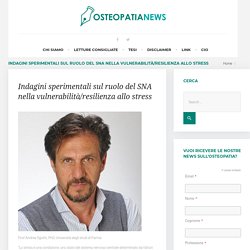
Quando l’organismo è in allarme si produce una risposta adattativa sia fisiologica che comportamentale atta a mantenere l’allostasi del sistema.
Tecniche non invasive per potenziare la variabilità della frequenza cardiaca - Osteopatianews. Dott.ssa Cristina Ottaviani – Università La Sapienza, Roma. Relazione tra osteopatia e SNA nel processo di recupero della salute - Osteopatianews. Evidenze e Razionale dell’applicazione clinica di Franco Guolo, DO Scarica l’articolo in pdf. Neural control of the ANS: blockade, lesion, and structural and functional imaging results - Osteopatianews. The Role of the Vagus Nerve in Cancer Prognosis: A Systematic and a Comprehensive Review. Qu’est-ce que la cohérence cardiaque. J Clin Psychiatry/Chronic Vagus Nerve Stimulation Significantly Improves Quality of Life in Treatment-Resistant Major Depression. Meaning of the Solid and Liquid Fascia to Reconsider the Model of Biotensegrity.
A Vagus Nerve Survival Guide to Combat Fight-or-Flight Urges. Medically accurate illustration of the vagus nerve. Source: Sebastian Kaulitzki/Shutterstock All too often, the readily accessible power of the vagus nerve to lower anxiety and reduce inflammation is overlooked and underestimated. Over the years, I’ve written a wide range of Psychology Today blog posts that highlight practical ways to tap into the ability of your vagus nerve to combat the cortisol producing stress response of fight-or-flight.
Neuroanatomy, Cranial Nerve 11, Accessory (CN XI) - StatPearls - NCBI Bookshelf. The Influence of Breathing on the Central Nervous System. Equipollenze. Il chiarimento di AISO. Equipollenze. Il chiarimento di AISO EQUIPOLLENZA DEL TITOLO ESTERO IN OSTEOPATIA AL FUTURO TITOLO ITALIANO: NO, MAI Il nostro sistema è ancora culturalmente influenzato dal concetto di “equipollenza” come possibilità esclusiva di riconoscimento del titolo estero. A tal proposito si ricorda che la Legge 148/2002 non utilizza più tale termine e che per effetto dell’art. 9 è stata abrogata la precedente procedura di equipollenza.
(Link a cimea.it) Da questo si deduce che quando la legge 3 del 2018, all’articolo 7 (Individuazione e istituzione delle professioni sanitarie dell’osteopata e del chiropratico) parla di criteri per il riconoscimento dei titoli equipollenti NON sta parlando del futuro riconoscimento di eventuali titoli esteri ma esclusivamente dell’equipollenza dei titoli che, fino alla scrittura dei criteri, hanno permesso l’esercizio della professione di osteopata. Decreto del Presidente della Repubblica 31 agosto 1999, n. 394 Articolo 50. Dott. Equipollenze.
The Influence of Breathing on the Central Nervous System. Prematurità e Osteopatia: un aiuto per i bambini. - Riccardo Capello. Sensitization and Interoception as Key Neurological Concepts in Osteopathy and Other Manual Medicines.
Introduction: Input—Central Elaboration—Output Interoception can be described as the moment-to-moment representation process of body sensations coming from the body itself (Craig, 2002). A broader definition considers interoception as a multi-dimensional construct, which includes how people evaluate and react to these sensations (Cameron, 2001). Interestingly, several health problems involve altered interoceptive processes, including chronic pain (Schmidt et al., 1989), post-traumatic stress disorder (Wald and Taylor, 2008), affective disorders (Paulus and Stein, 2010), addiction (Naqvi and Bechara, 2010), eating disorders (Pollatos et al., 2008; Herbert and Pollatos, 2014), somatoform disorders (Mirams et al., 2012; Schaefer et al., 2012), and dissociative disorders (Hankin, 2012; Michal et al., 2014; Sedeno et al., 2014).
Intravaginal manipulations by (German) osteopaths: a new low point for clinical research into alternative medicine?
We recently discussed the deplorable case of Larry Nassar and the fact that the ‘American Osteopathic Association’ stated that intravaginal manipulations are indeed an approved osteopathic treatment. At the time, I thought this was a shocking claim. So, imagine my surprise when I was alerted to a German trial of osteopathic intravaginal manipulations.
Comportamento da tenere all’interno dello studio di Osteopata in relazione alla privacy -
Clinical functional anatomy of the pterygopalatine ganglion, cephalgia and related dysautonomias: A review. Anatomy, Integument, Fascias - StatPearls - NCBI Bookshelf. The Trigeminal Nerve and The Social Nervous System - Dr. Kate Klemer. Bordoni bruno - PubMed - NCBI. Anatomy, Pelvis, Muscle, Bulbospongiosus - StatPearls - NCBI Bookshelf. Fascia—Current knowledge and future directions in physiatry: Narrative review.
Istituto Superiore di Posturologia Neuro-Mio-Fasciale AIFIMM. Anatomy, Neck, Larynx, Nerves, Recurrent Laryngeal - StatPearls - NCBI Bookshelf. IL BAMBINO e la sua STRUTTURAZIONE PSICO-COMPORTAMENTALE secondo GDS. Joëlle Dewandeleer-Van Nieuwenhuyze, fisioterapista Viviane Kurrels, psicologa.
Stages
Osteopatia Quantica. Image Library. Diagnosis and Management of Piriformis Syndrome: An Osteopathic Approach.










